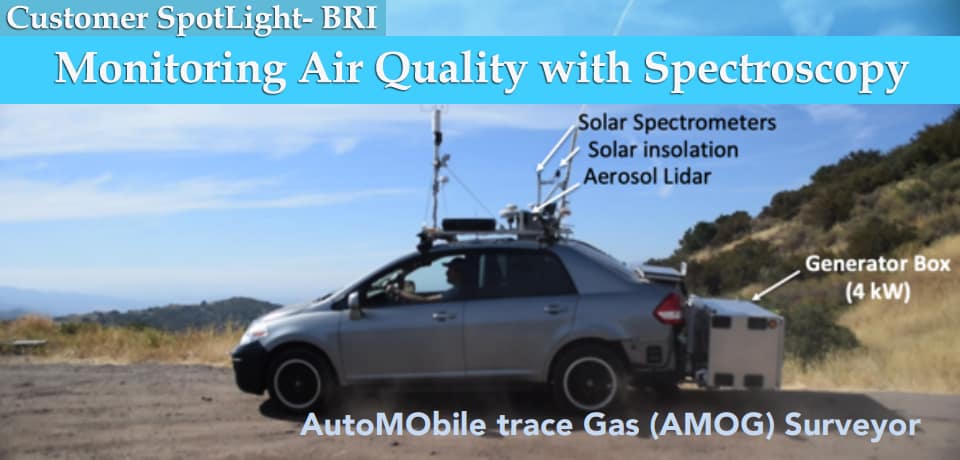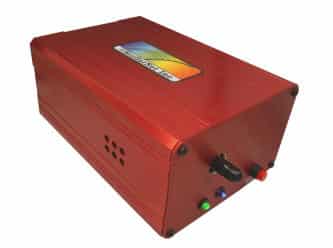
For air quality testing, Bubbleology Research International (BRI) provides a spectroscopic and in situ solution on a mobile platform that leverages the strengths of traditional sampling methods – the mobility of satellite measurements with the accuracy of stationary in situ testing. Air quality is one of the most important research topics in science right now – currently, the World Health Organization estimates 7 million people die annually from air pollution. Air quality research spans topics including smog, air quality effects on sensors for autonomous driving vehicles, climate change and health and human performance.
(Above) The AutoMObile trace Gas (AMOG) Surveyor system is available to be used by collaborators interested in atmospheric testing. Here, the AMOG is shown atop a mountain ridge during an air quality test.

Air Quality Data overlaid on the car’s route.

AMOG’s engine and suspension have been modified extensively to support safely AMOG’s high power needs (2.4kW) and weight (4500 pounds) to ensure high quality atmospheric data.
Air quality researchers typically focus on either satellite or stationary in situ measurements. Satellite imagery provides large area analysis, but could include data from the entire air column and resolution is limited by pixel size, which can be a hundred square kilometers. Alternatively, air quality researchers can use in situ instruments to take point measurements at far greater sensitivity; challenges include bringing often bulky instruments into the study area, and absent an airplane, the data are ground-based (or building-based). Moreover, there is no information on the air column above the station. Furthermore, thanks to its mobile nature, the AMOG Surveyor (pictured above) collects data where it needs to be collected, and at far higher resolution than satellite data. Specifically, stationary measurements often are not located downwind of sources in our ever-changing atmosphere. AMOG makes both highly sensitive surface measurements and column measurements. BRI does this using a custom-built, science car/mobile laboratory: AMOG Surveyor. “To improve the accuracy of aerosol profiles, we’ve incorporated a Mini Micro Pulse LiDAR (MiniMPL) instrument from Hexagon and a Grimm aerosol size analyzer. The fusion of these two data streams provides improved aerosol characterization – a pollutant of major concern,” says Dr. Ira Leifer.
HISTORY OF BUBBLEOLOGY RESEARCH INTERNATIONAL (BRI)
Begun in 2003, the southern California-based BRI’s business began to rapidly expand in 2010 after a successful project with the UK government, funded by ExxonMobil, to assess the amount of methane coming out of an abandoned gas well site in the center of the North Sea. The mobile solution has been tested extensively, collecting over 44,000 km of data (equivalent to an around the world drive) in southern California. The aerosol profile measurement provides the boundary layer height, and by analyzing the absorption of sunlight through that layer, AMOG sensors and proprietary analysis techniques characterize vertical air quality to kilometers above the surface.

The BRI AutoMObile trace Gas (AMOG) Surveyor system, pictured in front of an oil and gas processing plant, measuring methane and other trace gases and also vertical column information above the car.
BRI has pioneered the technique of using (nearby) mountains to validate the analysis. Within just 40 minutes AMOG can ascend from BRI’s sea level lab to 1300 meters high and back. AMOG measures a variety of gases, aerosol size distribution and profile, and column ozone and water vapor. BRI is currently working to add a methane column measurement capability to its in situ methane measurement.
AMOG Surveyor was mobilized to study the Aliso Canyon gas leak in 2015 for NASA. This event is regarded as the largest natural gas leak ever in the United States (Aliso Canyon Gas Leak). During the release, BRI sent the mobile system to follow the methane plume down the mountain (via roads) and into northern Los Angeles communities. Data confirmed that the Santa Ana winds were driving the lighter-than-air methane downslope, following the surface (where people live).
Satellite data showed the plume passed through the coastal mountains out over the Pacific Ocean, where it took a left turn back towards the Los Angeles airport. This study demonstrated the value of validated satellite data analysis – had the leak included a highly toxic gas, evacuation plans should have been applied to unsuspecting communities near the airport. Results from the Aliso study were published in the journal, Frontiers in Science.

AIR QUALITY DATA FROM THE RIDGE DRIVE: Y-axis is distance in meters (m) from 0 to 900 m. Ascent data is in blue and descent data is in red. X-axis measurements are (from left to right): Methane CH4 (ppm), Carbon dioxide CO2 (ppm), Ammonia NH3 (ppb), Carbonyl Sulfide COS (ppb), Sulfur Dioxide SO2 (ppb), Ozone O3 (ppb), Nitrogen Oxides NOX (ppb), water vapor H2O (ppb), and Particle count in the 2.5 micron size bucket PM2.5 (count). ppb = parts per billion; ppm = parts per million.
USING A RED-WAVE-NIRX-SR SPECTROMETER
The mobile platform has 23 scientific instruments, which make a total of 31 measurements including of 13 trace gases, meteorology, solar spectra, and other parameters. One of the sensors on the mobile platform is StellarNet’s near infrared Red-Wave-NIRX-SR spectrometer. The Red-Wave-NIRX-SR was chosen both for its performance and price and coverage of an important methane absorption feature, as well as the service provided by the StellarNet team to enable integration and to support BRI’s calibration laboratory. “Many customers want our products to be user friendly, plug-and-play devices with easy to-use, integrated user interfaces,” says David Parrino. “However, for BRI, data-friendly is key. BRI has so many systems on its mobile platform, it needs immediate access to the raw data, to be analyzed alongside the other system data, all in real time while driving around the study area.” “StellarNet has great people who are receptive to our needs as a unique customer,” says Ira Leifer, founder of BRI.
StellarNet has a variety of NIR Spectrometer options. Click here to see our NIR spectrometer line-up.
AIR QUALITY MONITORING IN LARGE CITIES
Whereas mobile platforms are excellent for research data collection, permanent installations do not need a driver and are critical to urban air quality monitoring. BRI is developing a stationary version of AMOG for remote deployment in permanent structures or trailered into a field for measurements at individual locations. With BRI’s column spectroscopic and lidar technologies, the entire air column can be analyzed with a fixedplace system. BRI welcomes discussions with organizations interested and able to bring this kind of air quality monitoring systems to market.
AMOG ADVANTAGES
● HYPER-LOCAL, HYPER-PRECISE RESULTS COMPARED TO SATELLITE – For targetable orbital sensors,
there is time and often-significant costs to scheduling satellite data collection, and satellite data pixels
are not local. Also, BRI achieves accuracies of 10s to 100 ppt on trace gases.
● ROBUSTNESS COMPARED TO SINGLE-MEASUREMENT PLATFORMS – Multiple sensing technologies are
collected at the same time and place, and analyzed in real time, allowing more robust interpretation.
● MORE READILY MOBILIZED THAN AIRPLANES – In the case of an air quality emergency, such as a forest
fire or chemical leak, a car can be out on the road taking measurements almost immediately and almost
anywhere people are located; relying on airplanes for rapid response is impractical outside a few
government agencies.
● BETTER THAN RESEARCH DRONES – The BRI mobile solution can characterize the vertical profile
including the boundary layer, which in states like Florida may extend to 15,000 ft, much higher than the
range of a research drone with single measurement techniques on board and at far higher accuracy.
BRI WELCOMES COLLABORATORS
AMOG is ready to roll! Some of its scientific results are published in seven (and counting) peer-reviewed papers. Additional capabilities are being added continuously to the system, such as a pyranometer and a pyrgeometer. BRI wants to collaborate with researchers who are looking to include AMOG’s unique capabilities to address interesting air quality problems. Research areas of interest include:
- Satellite data validation
- Understanding the vertical pollutant profiles (aerosols, ozone, etc.)
- Combining with airborne data to more completely characterize the atmosphere BRI is happy to work with atmospheric research scientists at universities, private companies, or agencies like NASA and California Air Resources Board (CARB). Writing a grant? Contact BRI to find out how invaluable AMOG data is to your next research project.
ABOUT BRI
Bubbleology Research International (BRI) is a small, flexible company dedicated to environmental consulting, instrumentation development, satellite analysis and validation, and environmental assessment. At BRI, we continuously adapt to change to meet our clients’ demands. Established in 2003, BRI can handles complex projects; subcontracting multi-institution, international projects for Fortune 500 companies, universities, the United States Navy, NASA, ESA (European Space Agency), and other government agencies. Over the years BRI has developed strategic partnerships with companies such as Los Gatos Research a member of the ABB group, Micro Pulse LIDAR, part of Hexagon, among others. Email: info@bubbleology.com Phone: (805) 683-3333 Pacific Time Zone http://bubbleology.com/






